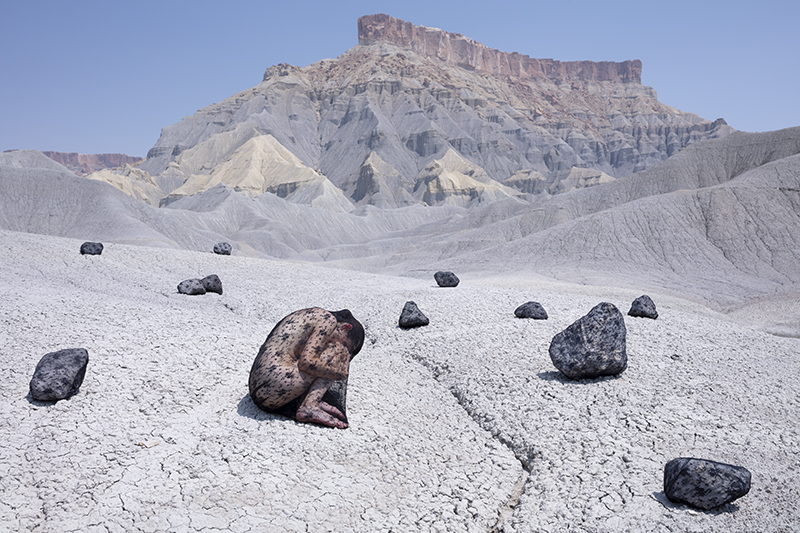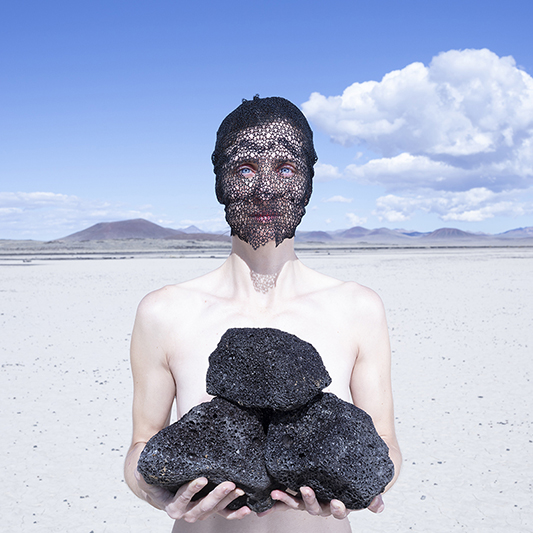Trilogía del alma

RITO V # 1. 2019, mineral ink on baryta photo paper, 100 x 150 cm.

RITO V # 1. 2019, mineral ink on baryta photo paper, 100 x 150 cm.

RITO X # 1. 2019, mineral ink on baryta photo paper, 100 x 150 cm.

RITO III. 2019, mineral ink on baryta photo paper, 100 x 150 cm

RITO VII. 2019, mineral ink on baryta photo paper, 100 x 150 cm.

RITO XIX. 2019, mineral ink on baryta photo paper, 100 x 150 cm.

Rito XXI. 2019, mineral ink on baryta photo paper, 100 x 150 cm

RITO XXVII. 2019, mineral ink on baryta photo paper, 100 x 150 cm

Rito VI # 2. 2019, mineral ink on baryta photo paper, 50 x 75 cm

RITO XIV. 2019, mineral ink on baryta photo paper, 100 x 150 cm

CHAMANA II. 2019, mineral ink on baryta photo paper, 60 x 60 cm
Zara Fernández de Moya (Comisaria)
En este espacio de la antigua cárcel de Segovia, convertido simbólicamente por Soledad Córdoba en un templo, se presenta al público por primera vez Trilogía del alma: Trascendencia, donde su cuerpo de mujer, elemento central de toda su obra, se funde con el desierto como un organismo animado, como región irreductible donde explorar diferentes estados del alma (génesis de sus visiones poéticas) en los que lo bello y lo sublime, como diría Eugenio Trías, en tanto que categoría única, se manifestaría como “presencia divina, encarnación, revelación del infinito en lo finito”.
La trilogía de Soledad Córdoba parecería revelar así el sentimiento romántico de lo sublime, donde, siguiendo al citado filósofo, “lo infinito se mete así en nosotros, en nuestra naturaleza anfibia de espíritus carnales”. Lo inconmensurable, el desierto abismal, es contemplado y habitado por un sentimiento ambivalente de angustia y gozo. La conciencia de la superioridad de la naturaleza llevaría a la artista a preguntarse por los enigmas primordiales, por los estados del alma ya explorados en Devastación y Resistencia, germen de esta Trilogía del alma. En estos proyectos seminales, las obras actúan como pruebas de una transformación devenida tras una experiencia desoladora, y a su vez funcionan como un medio para encontrar una vía de sanación (Devastación) o son «acciones de fuerza», bajo la pregunta de si resistir es existir (Resistencia). El visitante, por lo tanto, podrá recorrer los diferentes estados a través de fotografías, vídeos, instalaciones y dibujos, como expresión universal del alma caleidoscópica, acompañando el propio proceso de transformación de la artista.
En esta travesía hacia la inmensidad, hacia sí misma, Soledad elige el desierto como lugar propicio para la revelación, para la trascendencia. Ella misma lo relata como un camino místico, un viaje iniciático, o el camino misterioso que describía Novalis, “que va hacia el interior; dentro de nosotros, donde está la eternidad con sus mundos, el pasado y el porvenir”.
En el conjunto de sus visiones poético-performativas gravitan símbolos que conforman su mitología personal: la piedra, las cuerdas, el velo negro, el hilo-oro o la rosa negra. Elementos de su exploración espiritual que conectan con lo inefable y lo intangible, y nos invitan a penetrar en los abismos del inconsciente, de las grandes revelaciones, pero también, como apuntara José Jiménez, en su proceso consciente de superación personal: “Arrastrar las piedras de la existencia, girar en torno a ellas, hasta conseguir dominarlas, convertirlas en escala de la elevación”. Desde arriba, trascendida, las imágenes de Soledad Córdoba provocan estremecimiento y verdad. Obedecen a una exigencia imperiosa de su ser, no tienen nada que ver con la complacencia del yo. Son expresión universal del alma; de la mujer peregrina, guerrera, maga; de la mujer trascendida, purificada, renacida.
In this space within the ancient Segovia prison, symbolically transformed by Soledad Córdoba into a temple, the Trilogy of the Soul: Transcendence is presented to the public for the first time. Here, her female body, the central element of her entire body of work, merges with the desert as an animated organism—a irreducible region to explore different states of the soul (the genesis of her poetic visions). In these states, the beautiful and the sublime, as Eugenio Trías would put it, as a unique category, manifest as a "divine presence, incarnation, revelation of the infinite in the finite."
Soledad Córdoba's trilogy appears to reveal the romantic sentiment of the sublime, where, following the mentioned philosopher, "the infinite thus enters into us, into our amphibious nature of carnal spirits." The immeasurable, the abysmal desert, is contemplated and inhabited by an ambivalent feeling of anguish and joy. The awareness of the superiority of nature leads the artist to ponder primordial enigmas, states of the soul already explored in Devastation and Resistance, the germ of this Trilogy of the Soul. In these seminal projects, the works act as evidence of a transformation born out of a devastating experience, and they simultaneously serve as a means to find a path to healing (Devastation) or as "actions of force," questioning whether to resist is to exist (Resistance). Thus, visitors can navigate through different states via photographs, videos, installations, and drawings, as a universal expression of the kaleidoscopic soul, accompanying the artist's own process of transformation.
In this journey towards immensity, towards herself, Soledad chooses the desert as a conducive place for revelation, for transcendence. She describes it as a mystical path, an initiatory journey, or the mysterious road that Novalis described, "which goes inward; within us, where eternity with its worlds, the past, and the future reside." Within the ensemble of her poetic-performative visions, symbols gravitate that form her personal mythology: the stone, the strings, the black veil, the golden thread, or the black rose. Elements of her spiritual exploration that connect with the ineffable and the intangible, inviting us to penetrate the abysses of the unconscious, the great revelations, but also, as noted by José Jiménez, into her conscious process of personal overcoming: "Dragging the stones of existence, turning around them, until mastering them, turning them into the ladder of elevation." From above, transcended, Soledad Córdoba's images provoke shudders and truth. They obey an imperative demand of her being, having nothing to do with self-complacency. They are a universal expression of the soul; of the pilgrim, warrior, mage woman; of the transcended, purified, reborn woman.
* Exhibition at La Cárcel Centro de Creación Segovia Proyecto realizado con la Beca Leonardo a Investigadores y Creadores Culturales 2017, Fundación BBVA Project supported by a 2017 Leonardo Grant for Researchers and Cultural Creators, BBVA Foundation